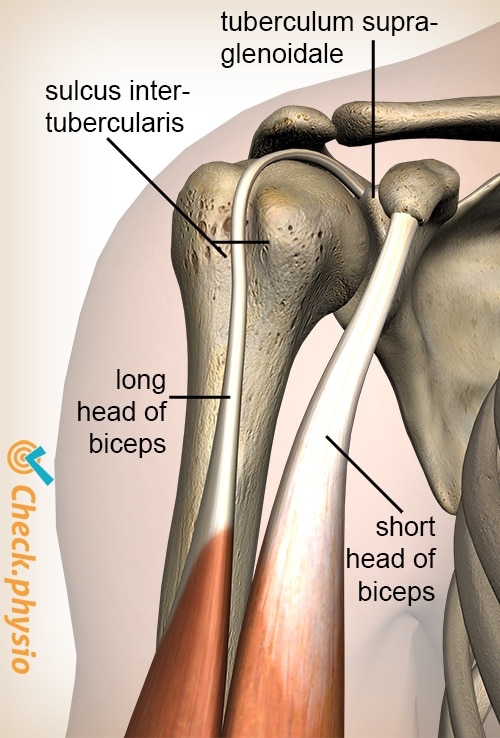Proximal biceps injury
Biceps tendinitis / biceps tendinosis / biceps subluxation / biceps rupture
The biceps is the large muscle in the upper arm, the main function of which is to flex the elbow. It runs from the forearm over the front of the upper arm and into the shoulder. Biceps problems are often felt along the front of the shoulder and in the upper arm.

If the condition is located further down toward the elbow, then it is referred to as a distal biceps injury.
Description of condition
With biceps tendinitis, the biceps tendon is inflamed. Tendinosis refers to decreased quality of the tendon (degeneration). This occurs with aging or through inactivity.
The long head of the biceps tendon runs along the front of the shoulder through a groove in the bone of the upper arm. We call this groove the "sulcus intertubercularis" (bicipital groove). Tissue is stretched over the groove in order to keep the tendon in the groove and together with the bicipital groove this forms a tunnel. If this "transverse humeral ligament" tears, the biceps can move out of its groove and cause symptoms. This is referred to as (sub)luxation of the biceps tendon.
In most cases of a rupture, the long head of the biceps tendon tears. The risk of a rupture increases with increasing degeneration of the tendon.
Cause and history
Proximal biceps injuries often occur as a result of other shoulder injuries. The cause can therefore often be found in other conditions.
In five percent of cases, a proximal biceps tendon injury occurs without any other shoulder injury. This includes acute trauma moments such as:
- Falling onto an outstretched arm.
- Excessive lifting.
- Overhead sport activities.
Signs & symptoms
Pain along the front of the shoulder that becomes worse during movements above shoulder height or when lifting heavy objects. The symptoms may sometimes be provoked by pressing on the biceps tendon on the front of the shoulder at the level of the bicipital groove (see image).
A subluxation may result in the above-mentioned symptoms, in addition to the patient regularly feeling something move along the front of the shoulder. The tendon of the long head of the biceps is leaving the bicipital groove during movement. This may produce a snapping sound or sensation.
In the event of a rupture, the long head of the biceps tendon tears. The patient clearly feels something snap in their shoulder at the moment that a force is being exerted on the tendon. This can occur during sports or when lifting a heavy object. A noticeable lump forms along the front inside of the upper arm. This is the long head of the muscle body of the biceps that has partially separated.
Diagnosis
An initial diagnosis can be made by questioning the patient about the symptoms and a physical examination. Because a proximal biceps injury is often a consequence of another shoulder disorder, the entire shoulder will need to be tested.
If instability or a rupture of the biceps tendon is suspected, imaging tests are necessary to reach the correct diagnosis. Unless a Popeye deformity is present, a rupture is the only possibility and additional testing is not necessary for this reason. However, in this case additional testing may be advised to check for any other shoulder injuries.
Additional testing may consist of X-rays, ultrasound or an MRI.
Treatment
Treatment depends on many factors.
Biceps tendinopathy (biceps tendinitis)
Biceps tendinopathy is treated conservatively (not surgically). Treatment consists mainly of physiotherapy and possibly painkillers or anti-inflammatory drugs. The physiotherapist has various treatment options for this. Because tendinopathy is caused by strain or other shoulder disorders, the emphasis is on repairing the tendon tissue. This requires "relative" rest, movements that provoke the pain should be avoided. In addition, the treatment will mainly consist of optimizing the shoulder movement. This can be done by using mobilization techniques and by training the shoulder muscles.
Biceps tendon instability
Instability of the biceps tendon often calls for an operation. The tendon is reattached or the tendon is moved. This depends on the degree of dislocation and any other muscle tears. A dislocation often occurs as a result of other muscle tears. During the operation, the biceps tendon is repaired and other conditions in the shoulder are treated.
Biceps tendon rupture
A biceps tendon rupture is usually treated conservatively in the same way as biceps tendinopathy. Surgery for a biceps tendon rupture is rarely recommended. Despite the bulge in the biceps, strength is almost completely preserved. Surgery may be recommended for overhead athletes if function does not fully return after the rehabilitation process.
Exercises
You can check your symptoms using the online physiotherapy check or make an appointment with a physiotherapy practice in your locality.

References
Catherine, A. & Churgay, M.D. (2009). Diagnosis and treatment of biceps tendinitis and tendinosis. Am Fam Physician. 2009;Sep 1;80(5):470-476.
Malik, S., Chiampas, G. & Leonard, H. (2010). Emergent evaluation of injuries to the shoulder, clavicle, and humerus. Emerg Med Clin N Am 2010;28:739-763.
Verhaar, J.A.N. & Linden, A.J. van der (2005). Orthopedie. Houten: Bohn Stafleu van Loghum.



